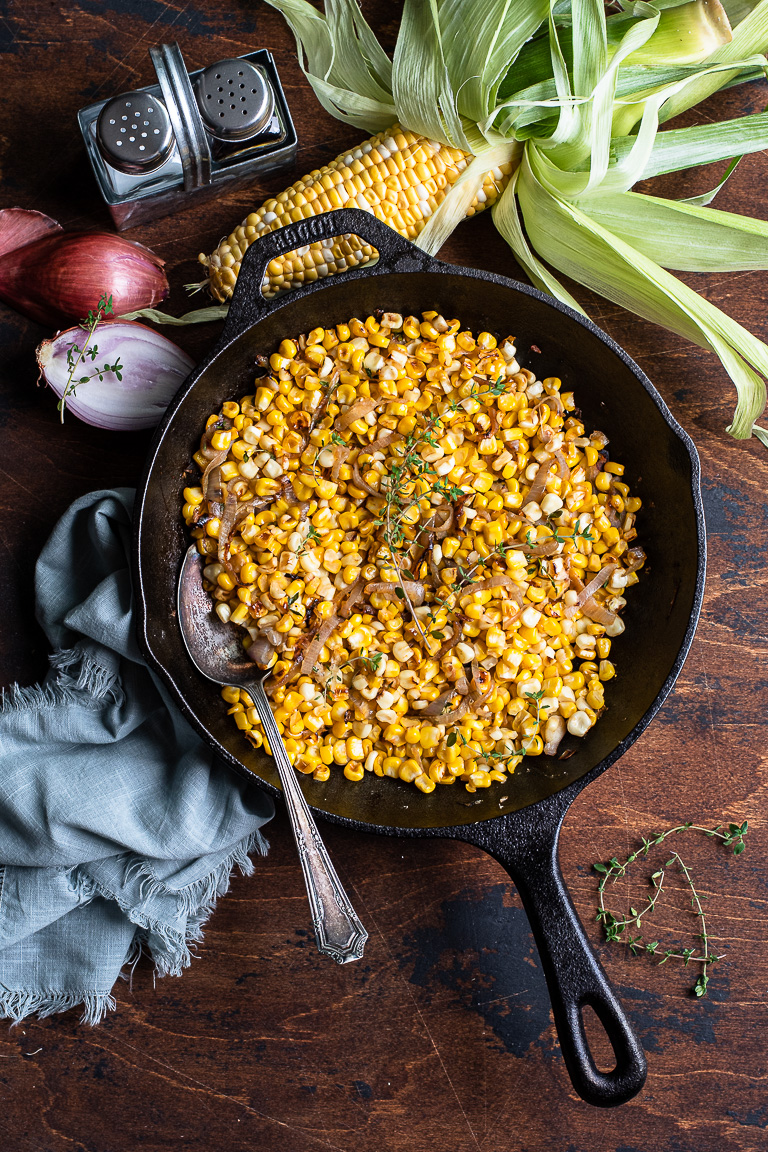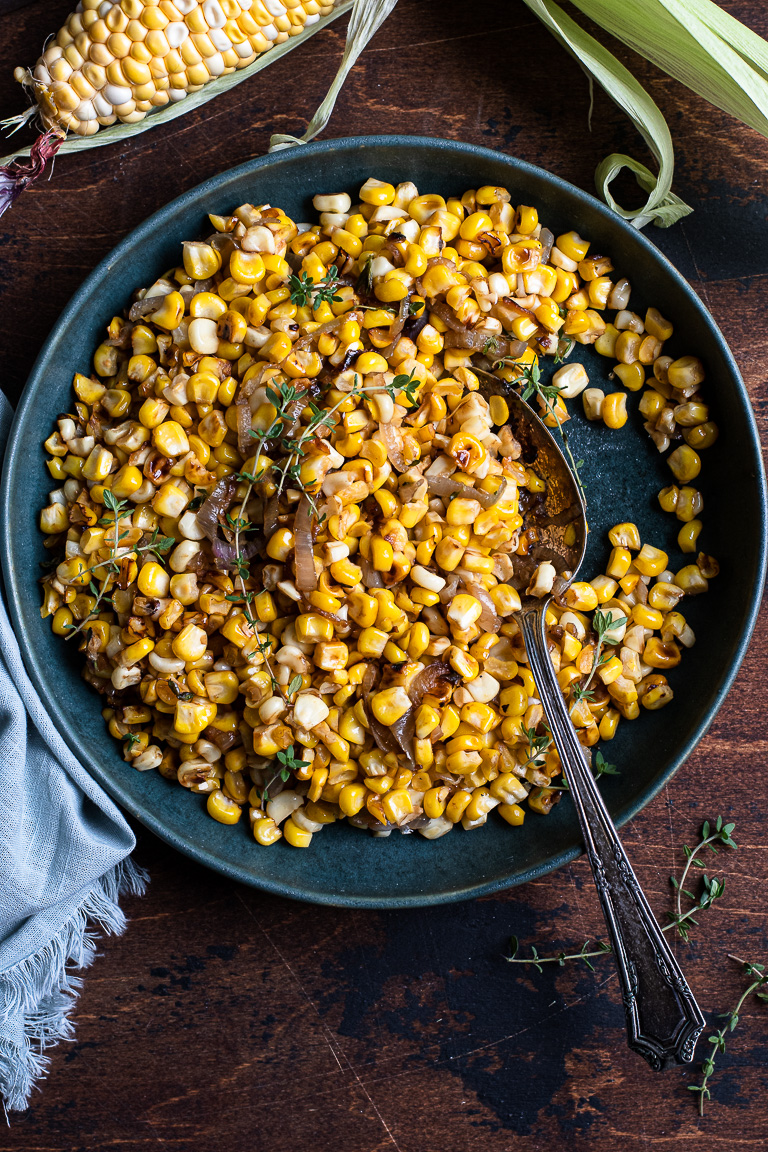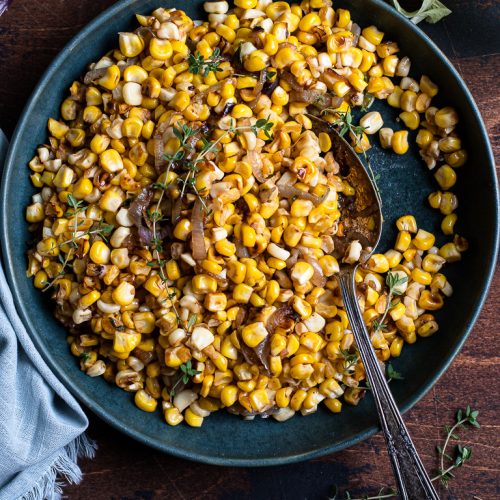Jersey corn. It's sweet, crisp and in abundance right now. I love searching for new ways to incorporate corn into my summer meals. Aside from the common way of eating it straight off the cob, sautéing corn is a great way to bring out its sweetness and create new dimensions of flavor. So if your stuck in a corn rut, this week I've got the perfect recipe to spice things up a little. Sautéed corn with caramelized shallots and thyme is full of flavor and so easy to make. What's even better is that it's ready in just 15 minutes! This recipe is both vegan and gluten-free.
All You Need Are 3 Ingredients
Corn
No surprise here. Fresh corn will yield the most desirable results, however defrosted frozen corn will work in a pinch.
From a nutrition standpoint I love corn because it contains a ton of fiber and it's a vegetable most enjoy. Even though people think corn is high in sugar because it tastes so sweet, it's much less than people realize. With only about 6 grams per cob, that small amount of sugar is absorbed slowly because of its high fiber content making corn a great choice even for those with blood sugar issues.
I normally buy corn from local farmer's markets in summer. Peel the husks from the corn and carefully slice the kernels off the cob with a sharp knife. The Kitchn does a great tutorial if you're interested in learning some tricks on how to do this without making a mess.
Shallots
Shallots provide just the right amount of oniony goodness to this recipe. They're sautéed in the pan before adding the corn, so they break down and caramelize. This adds a tremendous amount of flavor to the dish.
Thyme
There is something about fresh thyme leaves that goes so well with the corn and shallots. Thyme's slightly floral yet earthy flavor is the perfect compliment to the sweetness of the corn and caramelized shallots.

How To Make Sautéed Corn with Caramelized Shallots and Thyme
It couldn't be easier. Once you've prepped your vegetables the dish comes together very quickly. You can use a cast iron skillet or your favorite non-stick pan for this recipe.
- Add the sliced shallots to a hot pan with some olive oil.
- Lower the heat to medium and allow the shallots to cook down slowly, over about 5 minutes until they are slightly golden brown and begin to caramelize.
- Next, add the corn and fresh thyme leaves and cook for another 8-10 minutes until corn develops a rich golden color. Stir occasionally allowing the corn to sit still in the pan long enough to char a bit. This adds depth and flavor.
- Serve hot and with plenty of fresh thyme.
How To Serve + Use Leftovers
I normally serve corn with shallots and thyme as a side dish. It's great especially in summer with plant-based burgers, or meat and fish if that's your preference. I like to serve it warm, but it's also great at room temperature.
On rare occasions I do have leftovers. Here is where you can get a little creative.
Leftovers are great in salads, in pasta dishes, on top of pizza or in frittatas and omelettes.
I've also been known to use my leftovers in tacos along with some black beans. Delish!

If you enjoyed this dish you may also like this Black Bean and Mango Salad.

Sautéed Corn with Caramelized Shallots and Thyme
Equipment
- non stick pan
Ingredients
- 1 tablespoon extra virgin olive oil
- 4 cups corn husks removed and sliced from fresh corn cobs
- 2 shallots medium to large sized and sliced thin
- 1 teaspoon fresh thyme leaves removed from stem
- pinch sea salt
- pinch freshly ground pepper
Instructions
- Heat oil in a medium- sized non-stick pan on medium-high heat.
- Add shallots and saute until they begin to break down and caramelize and turn light golden brown (about 3-5 min).
- Add the corn and thyme and give it a quick stir in the pan.
- Allow the corn to sit about 3 minutes before stirring again.
- Stir and allow to sit another 3-5 minutes or until the corn is golden brown and slightly charred.
- Top with additional thyme leaves and a pinch of salt and pepper if desired.
Nutrition
I prefer to focus on quality ingredients from a variety of sources that work in tandem to promote optimal health. Nutrition calculations may not reflect these valuable interactions. However, I understand certain values can be helpful to some. Please note these calculations are merely estimates. Values will vary depending on modifications, brands used, and portion size. Should you require specific information, it's best to consult with a dietitian or qualified healthcare provider.



Leave a Reply